Food Safety Management Report for CERU Restaurant - Unit 31, HND
VerifiedAdded on 2020/10/22
|11
|3457
|163
Report
AI Summary
This report, based on a fast-food restaurant called CERU in London, delves into food safety management. It begins with an introduction to food safety, emphasizing its importance in the hospitality industry. The report then explores food spoilage agents, methods of food preservation, and their effectiveness. Key steps in temperature control systems are discussed, along with methods for safe food storage and the importance of personal hygiene. The report also covers cleaning and disinfection processes, pest control problems, hygienic design of food premises, and the role of training in quality assurance. Furthermore, it examines food hazard risk assessment and food safety control systems, concluding with a discussion on food safety guide for legislation compliance. The report underscores the significance of proactive measures to ensure food safety and prevent food-borne hazards within the food industry.
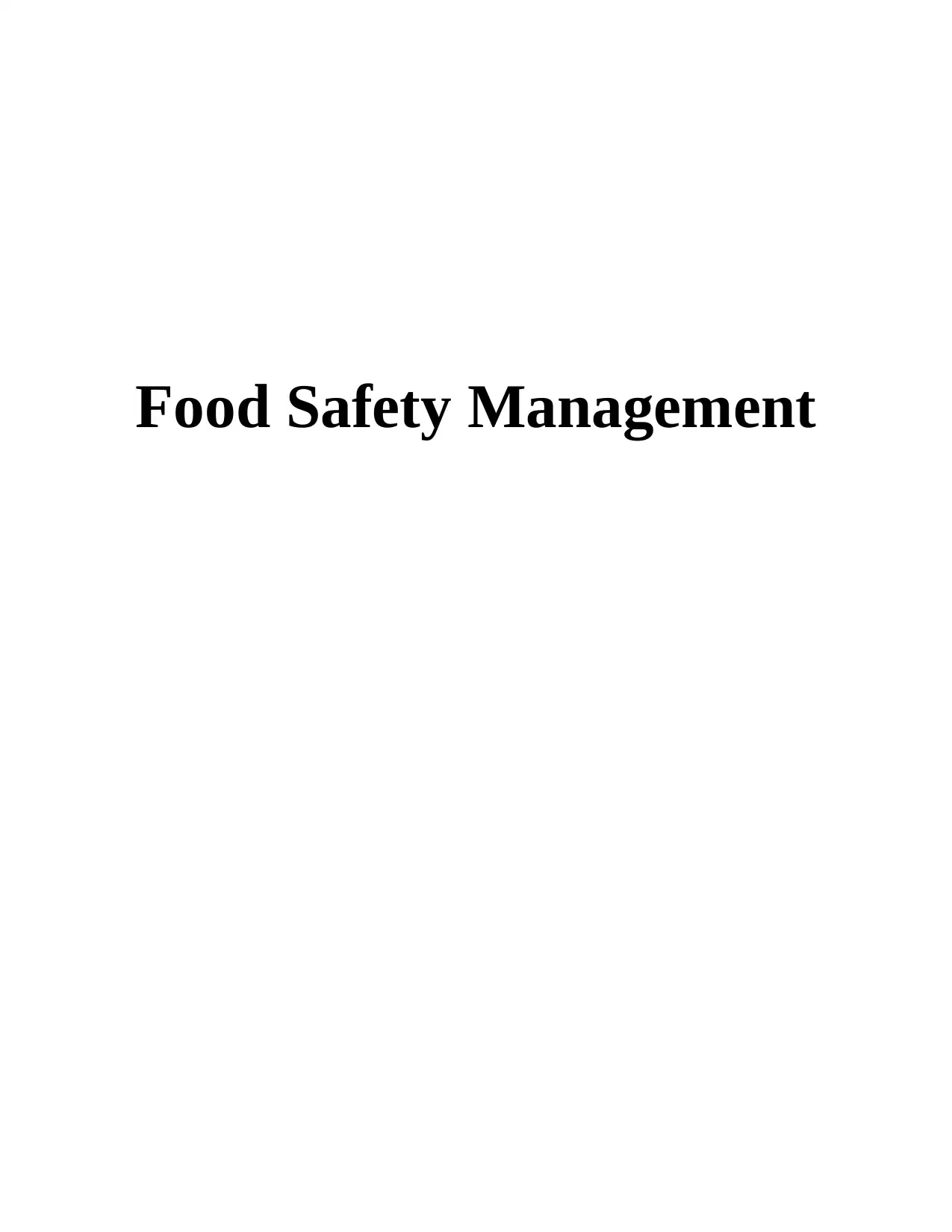
Food Safety Management
Paraphrase This Document
Need a fresh take? Get an instant paraphrase of this document with our AI Paraphraser
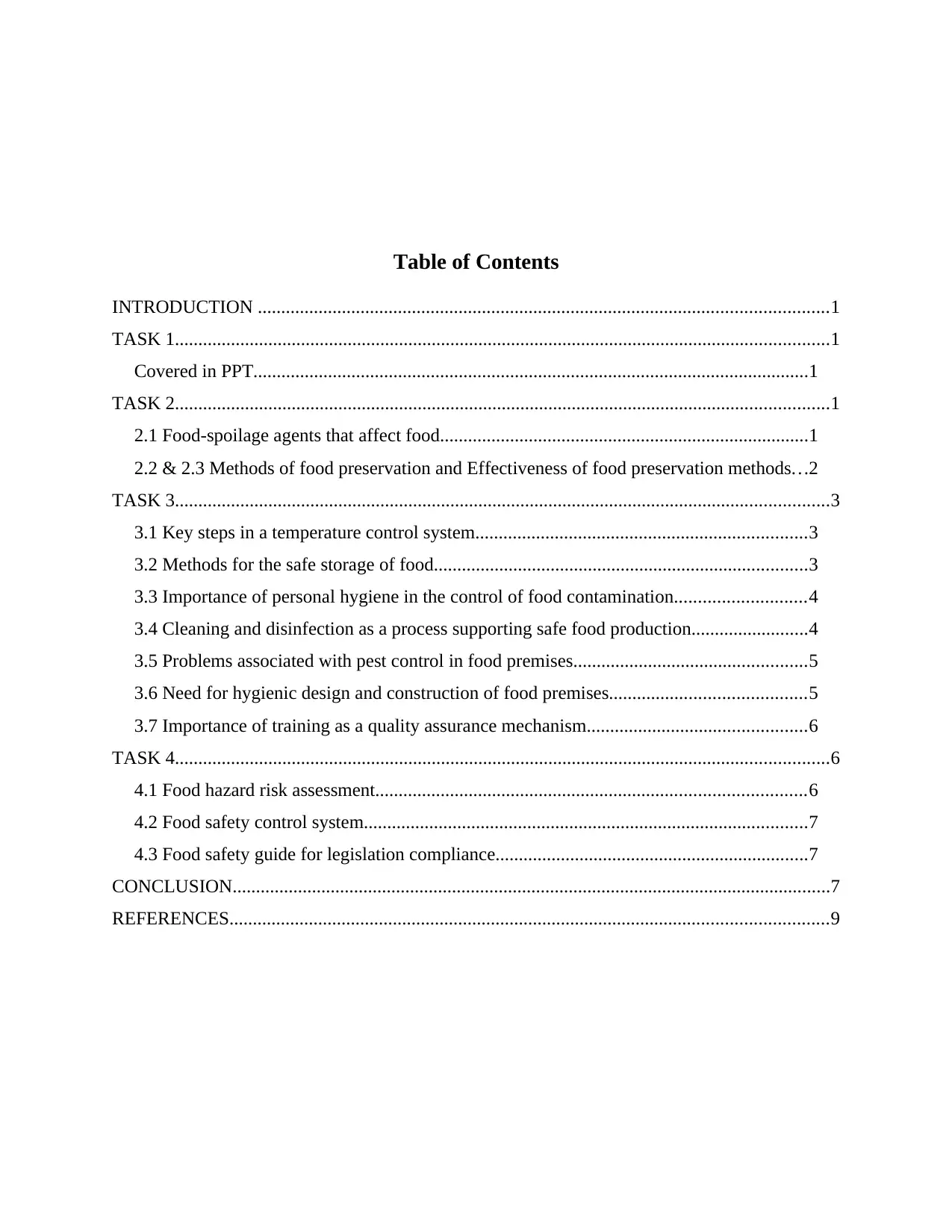
Table of Contents
INTRODUCTION ..........................................................................................................................1
TASK 1............................................................................................................................................1
Covered in PPT.......................................................................................................................1
TASK 2............................................................................................................................................1
2.1 Food-spoilage agents that affect food...............................................................................1
2.2 & 2.3 Methods of food preservation and Effectiveness of food preservation methods...2
TASK 3............................................................................................................................................3
3.1 Key steps in a temperature control system.......................................................................3
3.2 Methods for the safe storage of food................................................................................3
3.3 Importance of personal hygiene in the control of food contamination............................4
3.4 Cleaning and disinfection as a process supporting safe food production.........................4
3.5 Problems associated with pest control in food premises..................................................5
3.6 Need for hygienic design and construction of food premises..........................................5
3.7 Importance of training as a quality assurance mechanism...............................................6
TASK 4............................................................................................................................................6
4.1 Food hazard risk assessment............................................................................................6
4.2 Food safety control system...............................................................................................7
4.3 Food safety guide for legislation compliance...................................................................7
CONCLUSION................................................................................................................................7
REFERENCES................................................................................................................................9
INTRODUCTION ..........................................................................................................................1
TASK 1............................................................................................................................................1
Covered in PPT.......................................................................................................................1
TASK 2............................................................................................................................................1
2.1 Food-spoilage agents that affect food...............................................................................1
2.2 & 2.3 Methods of food preservation and Effectiveness of food preservation methods...2
TASK 3............................................................................................................................................3
3.1 Key steps in a temperature control system.......................................................................3
3.2 Methods for the safe storage of food................................................................................3
3.3 Importance of personal hygiene in the control of food contamination............................4
3.4 Cleaning and disinfection as a process supporting safe food production.........................4
3.5 Problems associated with pest control in food premises..................................................5
3.6 Need for hygienic design and construction of food premises..........................................5
3.7 Importance of training as a quality assurance mechanism...............................................6
TASK 4............................................................................................................................................6
4.1 Food hazard risk assessment............................................................................................6
4.2 Food safety control system...............................................................................................7
4.3 Food safety guide for legislation compliance...................................................................7
CONCLUSION................................................................................................................................7
REFERENCES................................................................................................................................9
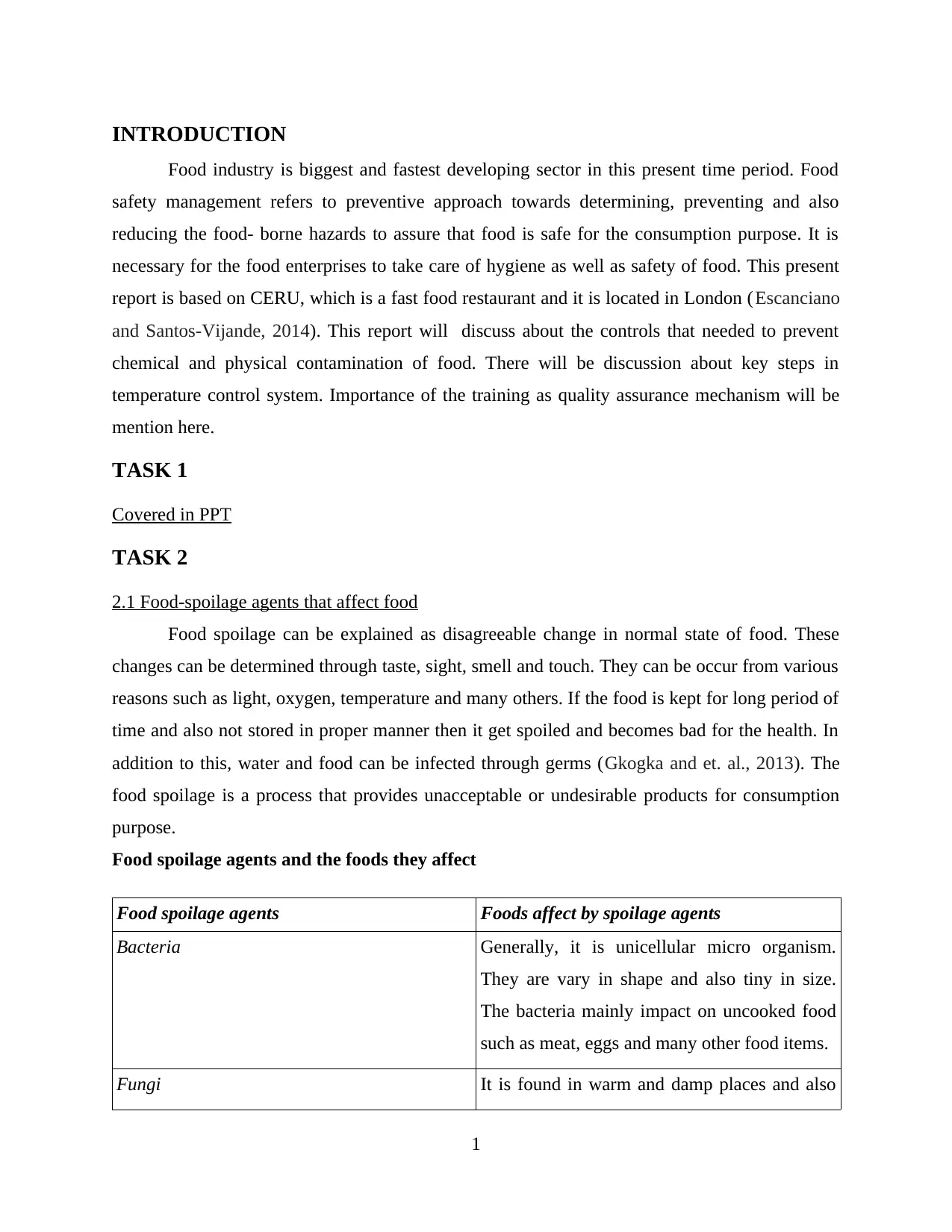
INTRODUCTION
Food industry is biggest and fastest developing sector in this present time period. Food
safety management refers to preventive approach towards determining, preventing and also
reducing the food- borne hazards to assure that food is safe for the consumption purpose. It is
necessary for the food enterprises to take care of hygiene as well as safety of food. This present
report is based on CERU, which is a fast food restaurant and it is located in London ( Escanciano
and Santos-Vijande, 2014). This report will discuss about the controls that needed to prevent
chemical and physical contamination of food. There will be discussion about key steps in
temperature control system. Importance of the training as quality assurance mechanism will be
mention here.
TASK 1
Covered in PPT
TASK 2
2.1 Food-spoilage agents that affect food
Food spoilage can be explained as disagreeable change in normal state of food. These
changes can be determined through taste, sight, smell and touch. They can be occur from various
reasons such as light, oxygen, temperature and many others. If the food is kept for long period of
time and also not stored in proper manner then it get spoiled and becomes bad for the health. In
addition to this, water and food can be infected through germs (Gkogka and et. al., 2013). The
food spoilage is a process that provides unacceptable or undesirable products for consumption
purpose.
Food spoilage agents and the foods they affect
Food spoilage agents Foods affect by spoilage agents
Bacteria Generally, it is unicellular micro organism.
They are vary in shape and also tiny in size.
The bacteria mainly impact on uncooked food
such as meat, eggs and many other food items.
Fungi It is found in warm and damp places and also
1
Food industry is biggest and fastest developing sector in this present time period. Food
safety management refers to preventive approach towards determining, preventing and also
reducing the food- borne hazards to assure that food is safe for the consumption purpose. It is
necessary for the food enterprises to take care of hygiene as well as safety of food. This present
report is based on CERU, which is a fast food restaurant and it is located in London ( Escanciano
and Santos-Vijande, 2014). This report will discuss about the controls that needed to prevent
chemical and physical contamination of food. There will be discussion about key steps in
temperature control system. Importance of the training as quality assurance mechanism will be
mention here.
TASK 1
Covered in PPT
TASK 2
2.1 Food-spoilage agents that affect food
Food spoilage can be explained as disagreeable change in normal state of food. These
changes can be determined through taste, sight, smell and touch. They can be occur from various
reasons such as light, oxygen, temperature and many others. If the food is kept for long period of
time and also not stored in proper manner then it get spoiled and becomes bad for the health. In
addition to this, water and food can be infected through germs (Gkogka and et. al., 2013). The
food spoilage is a process that provides unacceptable or undesirable products for consumption
purpose.
Food spoilage agents and the foods they affect
Food spoilage agents Foods affect by spoilage agents
Bacteria Generally, it is unicellular micro organism.
They are vary in shape and also tiny in size.
The bacteria mainly impact on uncooked food
such as meat, eggs and many other food items.
Fungi It is found in warm and damp places and also
1
⊘ This is a preview!⊘
Do you want full access?
Subscribe today to unlock all pages.

Trusted by 1+ million students worldwide
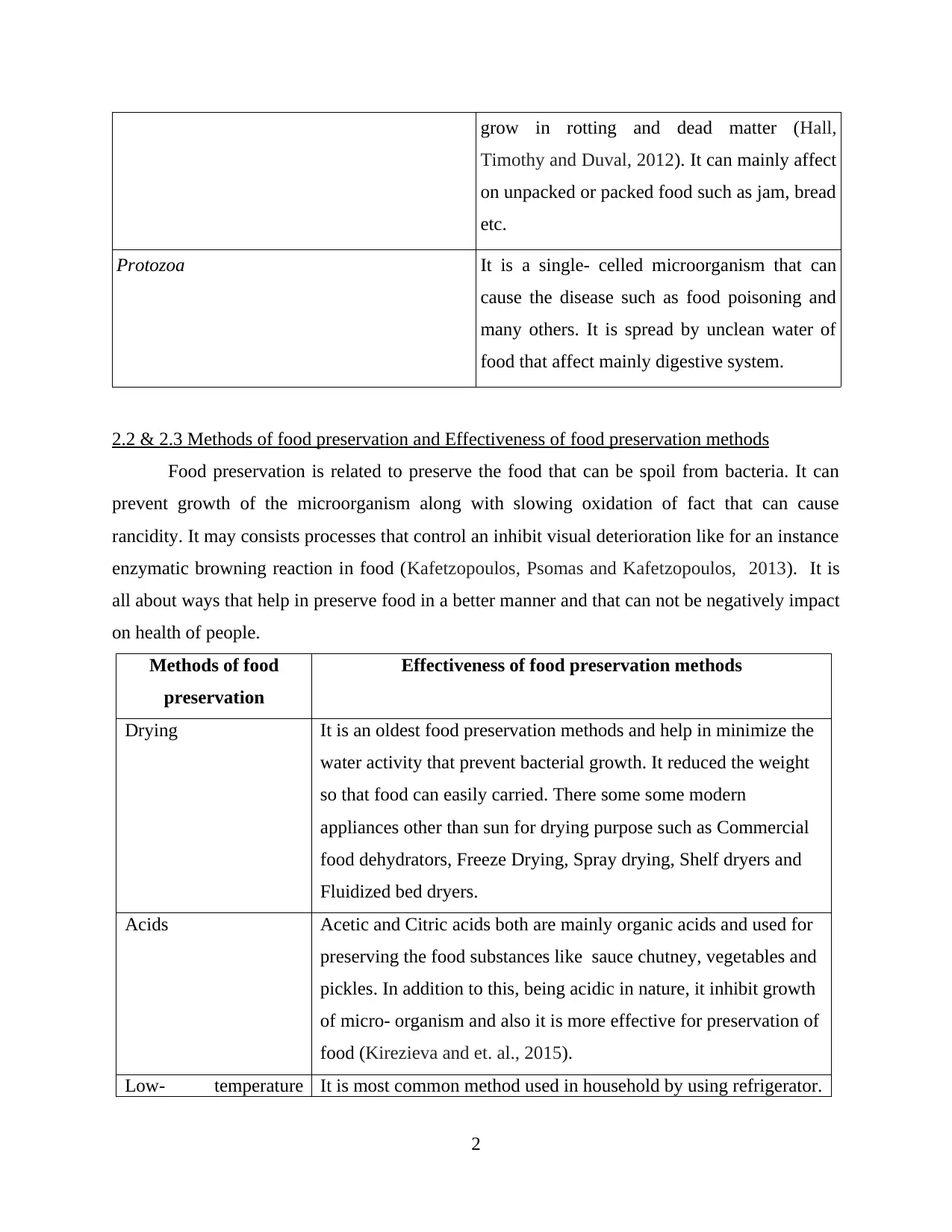
grow in rotting and dead matter (Hall,
Timothy and Duval, 2012). It can mainly affect
on unpacked or packed food such as jam, bread
etc.
Protozoa It is a single- celled microorganism that can
cause the disease such as food poisoning and
many others. It is spread by unclean water of
food that affect mainly digestive system.
2.2 & 2.3 Methods of food preservation and Effectiveness of food preservation methods
Food preservation is related to preserve the food that can be spoil from bacteria. It can
prevent growth of the microorganism along with slowing oxidation of fact that can cause
rancidity. It may consists processes that control an inhibit visual deterioration like for an instance
enzymatic browning reaction in food (Kafetzopoulos, Psomas and Kafetzopoulos, 2013). It is
all about ways that help in preserve food in a better manner and that can not be negatively impact
on health of people.
Methods of food
preservation
Effectiveness of food preservation methods
Drying It is an oldest food preservation methods and help in minimize the
water activity that prevent bacterial growth. It reduced the weight
so that food can easily carried. There some some modern
appliances other than sun for drying purpose such as Commercial
food dehydrators, Freeze Drying, Spray drying, Shelf dryers and
Fluidized bed dryers.
Acids Acetic and Citric acids both are mainly organic acids and used for
preserving the food substances like sauce chutney, vegetables and
pickles. In addition to this, being acidic in nature, it inhibit growth
of micro- organism and also it is more effective for preservation of
food (Kirezieva and et. al., 2015).
Low- temperature It is most common method used in household by using refrigerator.
2
Timothy and Duval, 2012). It can mainly affect
on unpacked or packed food such as jam, bread
etc.
Protozoa It is a single- celled microorganism that can
cause the disease such as food poisoning and
many others. It is spread by unclean water of
food that affect mainly digestive system.
2.2 & 2.3 Methods of food preservation and Effectiveness of food preservation methods
Food preservation is related to preserve the food that can be spoil from bacteria. It can
prevent growth of the microorganism along with slowing oxidation of fact that can cause
rancidity. It may consists processes that control an inhibit visual deterioration like for an instance
enzymatic browning reaction in food (Kafetzopoulos, Psomas and Kafetzopoulos, 2013). It is
all about ways that help in preserve food in a better manner and that can not be negatively impact
on health of people.
Methods of food
preservation
Effectiveness of food preservation methods
Drying It is an oldest food preservation methods and help in minimize the
water activity that prevent bacterial growth. It reduced the weight
so that food can easily carried. There some some modern
appliances other than sun for drying purpose such as Commercial
food dehydrators, Freeze Drying, Spray drying, Shelf dryers and
Fluidized bed dryers.
Acids Acetic and Citric acids both are mainly organic acids and used for
preserving the food substances like sauce chutney, vegetables and
pickles. In addition to this, being acidic in nature, it inhibit growth
of micro- organism and also it is more effective for preservation of
food (Kirezieva and et. al., 2015).
Low- temperature It is most common method used in household by using refrigerator.
2
Paraphrase This Document
Need a fresh take? Get an instant paraphrase of this document with our AI Paraphraser
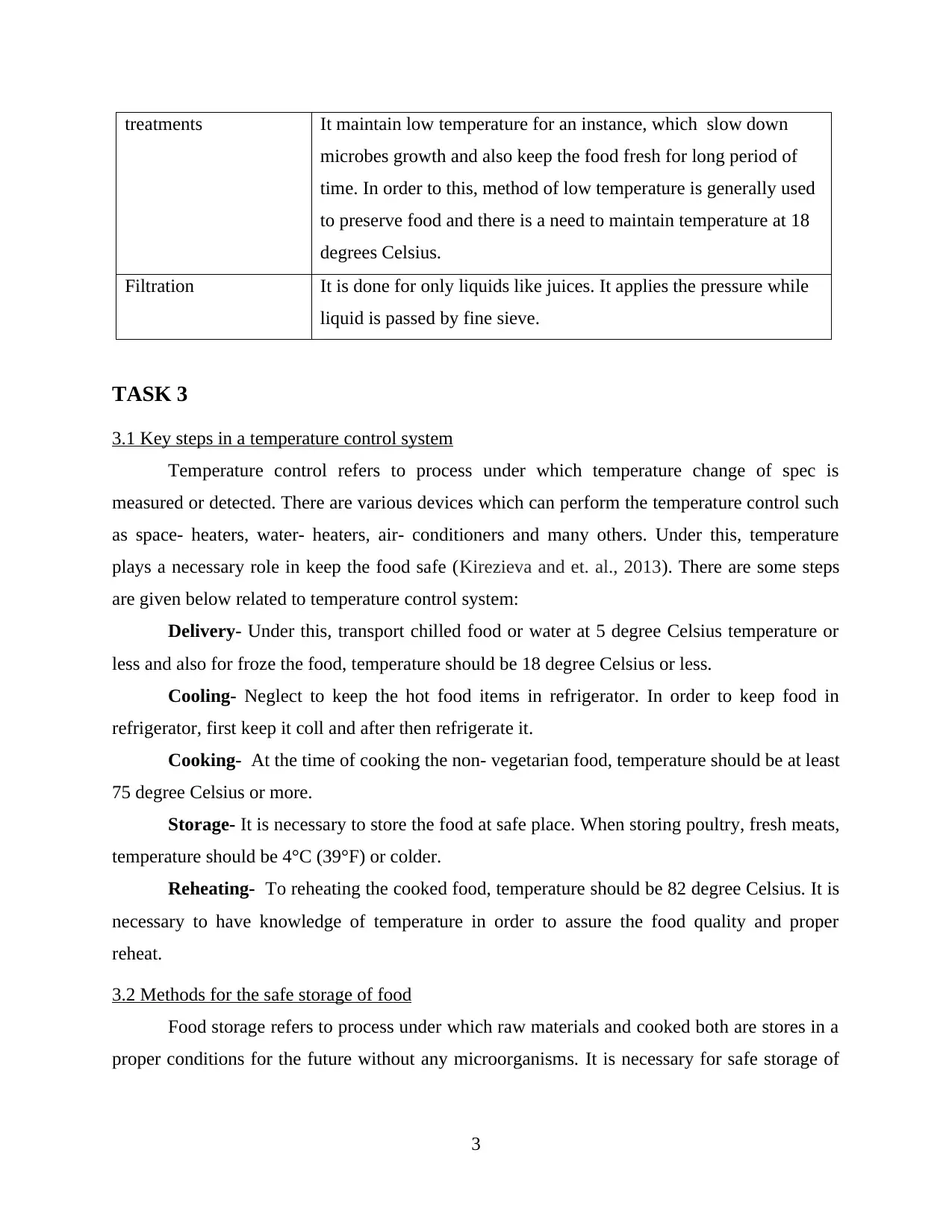
treatments It maintain low temperature for an instance, which slow down
microbes growth and also keep the food fresh for long period of
time. In order to this, method of low temperature is generally used
to preserve food and there is a need to maintain temperature at 18
degrees Celsius.
Filtration It is done for only liquids like juices. It applies the pressure while
liquid is passed by fine sieve.
TASK 3
3.1 Key steps in a temperature control system
Temperature control refers to process under which temperature change of spec is
measured or detected. There are various devices which can perform the temperature control such
as space- heaters, water- heaters, air- conditioners and many others. Under this, temperature
plays a necessary role in keep the food safe (Kirezieva and et. al., 2013). There are some steps
are given below related to temperature control system:
Delivery- Under this, transport chilled food or water at 5 degree Celsius temperature or
less and also for froze the food, temperature should be 18 degree Celsius or less.
Cooling- Neglect to keep the hot food items in refrigerator. In order to keep food in
refrigerator, first keep it coll and after then refrigerate it.
Cooking- At the time of cooking the non- vegetarian food, temperature should be at least
75 degree Celsius or more.
Storage- It is necessary to store the food at safe place. When storing poultry, fresh meats,
temperature should be 4°C (39°F) or colder.
Reheating- To reheating the cooked food, temperature should be 82 degree Celsius. It is
necessary to have knowledge of temperature in order to assure the food quality and proper
reheat.
3.2 Methods for the safe storage of food
Food storage refers to process under which raw materials and cooked both are stores in a
proper conditions for the future without any microorganisms. It is necessary for safe storage of
3
microbes growth and also keep the food fresh for long period of
time. In order to this, method of low temperature is generally used
to preserve food and there is a need to maintain temperature at 18
degrees Celsius.
Filtration It is done for only liquids like juices. It applies the pressure while
liquid is passed by fine sieve.
TASK 3
3.1 Key steps in a temperature control system
Temperature control refers to process under which temperature change of spec is
measured or detected. There are various devices which can perform the temperature control such
as space- heaters, water- heaters, air- conditioners and many others. Under this, temperature
plays a necessary role in keep the food safe (Kirezieva and et. al., 2013). There are some steps
are given below related to temperature control system:
Delivery- Under this, transport chilled food or water at 5 degree Celsius temperature or
less and also for froze the food, temperature should be 18 degree Celsius or less.
Cooling- Neglect to keep the hot food items in refrigerator. In order to keep food in
refrigerator, first keep it coll and after then refrigerate it.
Cooking- At the time of cooking the non- vegetarian food, temperature should be at least
75 degree Celsius or more.
Storage- It is necessary to store the food at safe place. When storing poultry, fresh meats,
temperature should be 4°C (39°F) or colder.
Reheating- To reheating the cooked food, temperature should be 82 degree Celsius. It is
necessary to have knowledge of temperature in order to assure the food quality and proper
reheat.
3.2 Methods for the safe storage of food
Food storage refers to process under which raw materials and cooked both are stores in a
proper conditions for the future without any microorganisms. It is necessary for safe storage of
3
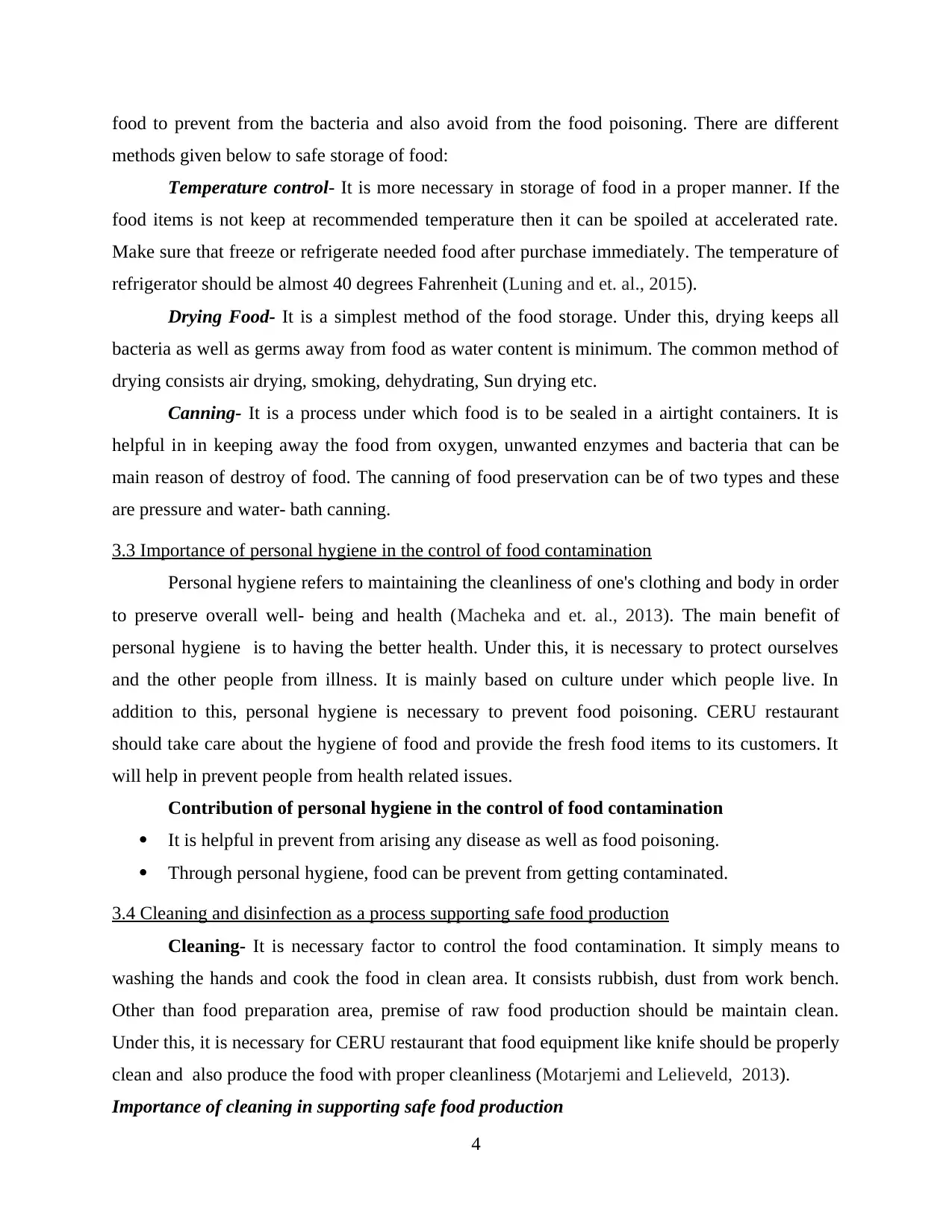
food to prevent from the bacteria and also avoid from the food poisoning. There are different
methods given below to safe storage of food:
Temperature control- It is more necessary in storage of food in a proper manner. If the
food items is not keep at recommended temperature then it can be spoiled at accelerated rate.
Make sure that freeze or refrigerate needed food after purchase immediately. The temperature of
refrigerator should be almost 40 degrees Fahrenheit (Luning and et. al., 2015).
Drying Food- It is a simplest method of the food storage. Under this, drying keeps all
bacteria as well as germs away from food as water content is minimum. The common method of
drying consists air drying, smoking, dehydrating, Sun drying etc.
Canning- It is a process under which food is to be sealed in a airtight containers. It is
helpful in in keeping away the food from oxygen, unwanted enzymes and bacteria that can be
main reason of destroy of food. The canning of food preservation can be of two types and these
are pressure and water- bath canning.
3.3 Importance of personal hygiene in the control of food contamination
Personal hygiene refers to maintaining the cleanliness of one's clothing and body in order
to preserve overall well- being and health (Macheka and et. al., 2013). The main benefit of
personal hygiene is to having the better health. Under this, it is necessary to protect ourselves
and the other people from illness. It is mainly based on culture under which people live. In
addition to this, personal hygiene is necessary to prevent food poisoning. CERU restaurant
should take care about the hygiene of food and provide the fresh food items to its customers. It
will help in prevent people from health related issues.
Contribution of personal hygiene in the control of food contamination
It is helpful in prevent from arising any disease as well as food poisoning.
Through personal hygiene, food can be prevent from getting contaminated.
3.4 Cleaning and disinfection as a process supporting safe food production
Cleaning- It is necessary factor to control the food contamination. It simply means to
washing the hands and cook the food in clean area. It consists rubbish, dust from work bench.
Other than food preparation area, premise of raw food production should be maintain clean.
Under this, it is necessary for CERU restaurant that food equipment like knife should be properly
clean and also produce the food with proper cleanliness (Motarjemi and Lelieveld, 2013).
Importance of cleaning in supporting safe food production
4
methods given below to safe storage of food:
Temperature control- It is more necessary in storage of food in a proper manner. If the
food items is not keep at recommended temperature then it can be spoiled at accelerated rate.
Make sure that freeze or refrigerate needed food after purchase immediately. The temperature of
refrigerator should be almost 40 degrees Fahrenheit (Luning and et. al., 2015).
Drying Food- It is a simplest method of the food storage. Under this, drying keeps all
bacteria as well as germs away from food as water content is minimum. The common method of
drying consists air drying, smoking, dehydrating, Sun drying etc.
Canning- It is a process under which food is to be sealed in a airtight containers. It is
helpful in in keeping away the food from oxygen, unwanted enzymes and bacteria that can be
main reason of destroy of food. The canning of food preservation can be of two types and these
are pressure and water- bath canning.
3.3 Importance of personal hygiene in the control of food contamination
Personal hygiene refers to maintaining the cleanliness of one's clothing and body in order
to preserve overall well- being and health (Macheka and et. al., 2013). The main benefit of
personal hygiene is to having the better health. Under this, it is necessary to protect ourselves
and the other people from illness. It is mainly based on culture under which people live. In
addition to this, personal hygiene is necessary to prevent food poisoning. CERU restaurant
should take care about the hygiene of food and provide the fresh food items to its customers. It
will help in prevent people from health related issues.
Contribution of personal hygiene in the control of food contamination
It is helpful in prevent from arising any disease as well as food poisoning.
Through personal hygiene, food can be prevent from getting contaminated.
3.4 Cleaning and disinfection as a process supporting safe food production
Cleaning- It is necessary factor to control the food contamination. It simply means to
washing the hands and cook the food in clean area. It consists rubbish, dust from work bench.
Other than food preparation area, premise of raw food production should be maintain clean.
Under this, it is necessary for CERU restaurant that food equipment like knife should be properly
clean and also produce the food with proper cleanliness (Motarjemi and Lelieveld, 2013).
Importance of cleaning in supporting safe food production
4
⊘ This is a preview!⊘
Do you want full access?
Subscribe today to unlock all pages.

Trusted by 1+ million students worldwide

Cleaning is helpful in remove germs, dirt and organic matter from surfaces.
It minimize chance of getting food contaminated at initial stage.
The cleaning with safe the food with any germs and bacteria.
Disinfection- It plays a necessary role in minimize microorganism to safe level. It is a
process of killing micro- organism with an aim of minimize them and prevent health of people.
Importance of disinfection in supporting safe food production
It can prevent spread of germs that can cause illness.
It is helpful in reduce the micro – organism to require food protection level.
It assess in keeping food fresh and also away from micro- organism (Powell and et. al.,
2013).
3.5 Problems associated with pest control in food premises
Pest control refers to regulation of species that explained as pest, members of animal and
adversely affect on activities of human. It can be attained through monitoring crop by applying
insecticides when required. It is necessary for CERU food restaurant to analyse better pest
control in areas related to food controlling in careful manner. In addition to this, appropriate
precautions which can be taken for prevent food detect from insects, rats, cockroaches that can
enter in food preparation area. Proper pest control will be helpful in preventing food from get
infected otherwise it can be cause of health issues. There are some issues related with pest
control in food premises mention below:
Control over the flying insects is more difficult in the area of food processing.
The spays can not be used as it consist risk of the chemical food contamination.
From pest control, CERU food restaurant can face some smell problem that can be
diluted in food and spoil it.
If the pest will not be control then it can create micro- organism.
3.6 Need for hygienic design and construction of food premises
Hygiene is first and foremost priority of an individual or business . Maintaining hygiene
at workplace is helpful in attracting more people towards workplace. In addition to this, it is
necessary for CERU food restaurant to develop the hygiene design of premises to make food
sage for customers. For maintaining the better standard of food, cleanliness and hygiene are
included as critical aspect (Sawe, Onyango. and Njage, 2014). In addition to this, it is necessary
that design and construction of food premises should be hygienic because it helps to develop
5
It minimize chance of getting food contaminated at initial stage.
The cleaning with safe the food with any germs and bacteria.
Disinfection- It plays a necessary role in minimize microorganism to safe level. It is a
process of killing micro- organism with an aim of minimize them and prevent health of people.
Importance of disinfection in supporting safe food production
It can prevent spread of germs that can cause illness.
It is helpful in reduce the micro – organism to require food protection level.
It assess in keeping food fresh and also away from micro- organism (Powell and et. al.,
2013).
3.5 Problems associated with pest control in food premises
Pest control refers to regulation of species that explained as pest, members of animal and
adversely affect on activities of human. It can be attained through monitoring crop by applying
insecticides when required. It is necessary for CERU food restaurant to analyse better pest
control in areas related to food controlling in careful manner. In addition to this, appropriate
precautions which can be taken for prevent food detect from insects, rats, cockroaches that can
enter in food preparation area. Proper pest control will be helpful in preventing food from get
infected otherwise it can be cause of health issues. There are some issues related with pest
control in food premises mention below:
Control over the flying insects is more difficult in the area of food processing.
The spays can not be used as it consist risk of the chemical food contamination.
From pest control, CERU food restaurant can face some smell problem that can be
diluted in food and spoil it.
If the pest will not be control then it can create micro- organism.
3.6 Need for hygienic design and construction of food premises
Hygiene is first and foremost priority of an individual or business . Maintaining hygiene
at workplace is helpful in attracting more people towards workplace. In addition to this, it is
necessary for CERU food restaurant to develop the hygiene design of premises to make food
sage for customers. For maintaining the better standard of food, cleanliness and hygiene are
included as critical aspect (Sawe, Onyango. and Njage, 2014). In addition to this, it is necessary
that design and construction of food premises should be hygienic because it helps to develop
5
Paraphrase This Document
Need a fresh take? Get an instant paraphrase of this document with our AI Paraphraser

positive impact on health of people. There are some requirement of hygienic construction and
design of food premises mention below:
The design of window in food premises of CERU restaurant should be properly
ventilated.
The devices of pest control should be places at the strategic location in order to reduce
number of infections as well as insects.
CERU should adopt the better cleaning methods and hygiene standards to assure clean,
hygiene and healthy environment with the clean sanitary facilities in proper manner.
It is necessary to provide the separate vegetable preparation and root vegetable area
(Escanciano and Santos-Vijande, 2014).
3.7 Importance of training as a quality assurance mechanism
Training is related with developing skills and knowledge to perform any work or
activities in a proper manner. It is necessary for each business firm to train its staff members in
order to maintaining quality services for consumers (Wu and Chen, 2013). The CERU restaurant
provides training to its staff members to managing many problems and also aware them about
hygiene standards. The importance of training as a quality assurance mechanism mention below:
Improve employee performance- Staff member that receive proper training is able to
perform the job in better manner. It is helpful in develop confidence in them and they will focus
on making the quality better.
Cutting down of wastage- The well- trained staff members can have proper or effective
knowledge about to cook and store food. It is helpful in minimize wastage along with food
spoilage.
TASK 4
4.1 Food hazard risk assessment
CERU is a fast food restaurant in London and it provides different variety of food items
on the basis of demands and needs of consumers. Assessment related to food hazard will help in
determining main factors of risk. On the other hand, assessment will helpful in measuring
problems which can be experienced at the time of making food at restaurant (Gkogka and et. al.,
2013).
6
design of food premises mention below:
The design of window in food premises of CERU restaurant should be properly
ventilated.
The devices of pest control should be places at the strategic location in order to reduce
number of infections as well as insects.
CERU should adopt the better cleaning methods and hygiene standards to assure clean,
hygiene and healthy environment with the clean sanitary facilities in proper manner.
It is necessary to provide the separate vegetable preparation and root vegetable area
(Escanciano and Santos-Vijande, 2014).
3.7 Importance of training as a quality assurance mechanism
Training is related with developing skills and knowledge to perform any work or
activities in a proper manner. It is necessary for each business firm to train its staff members in
order to maintaining quality services for consumers (Wu and Chen, 2013). The CERU restaurant
provides training to its staff members to managing many problems and also aware them about
hygiene standards. The importance of training as a quality assurance mechanism mention below:
Improve employee performance- Staff member that receive proper training is able to
perform the job in better manner. It is helpful in develop confidence in them and they will focus
on making the quality better.
Cutting down of wastage- The well- trained staff members can have proper or effective
knowledge about to cook and store food. It is helpful in minimize wastage along with food
spoilage.
TASK 4
4.1 Food hazard risk assessment
CERU is a fast food restaurant in London and it provides different variety of food items
on the basis of demands and needs of consumers. Assessment related to food hazard will help in
determining main factors of risk. On the other hand, assessment will helpful in measuring
problems which can be experienced at the time of making food at restaurant (Gkogka and et. al.,
2013).
6
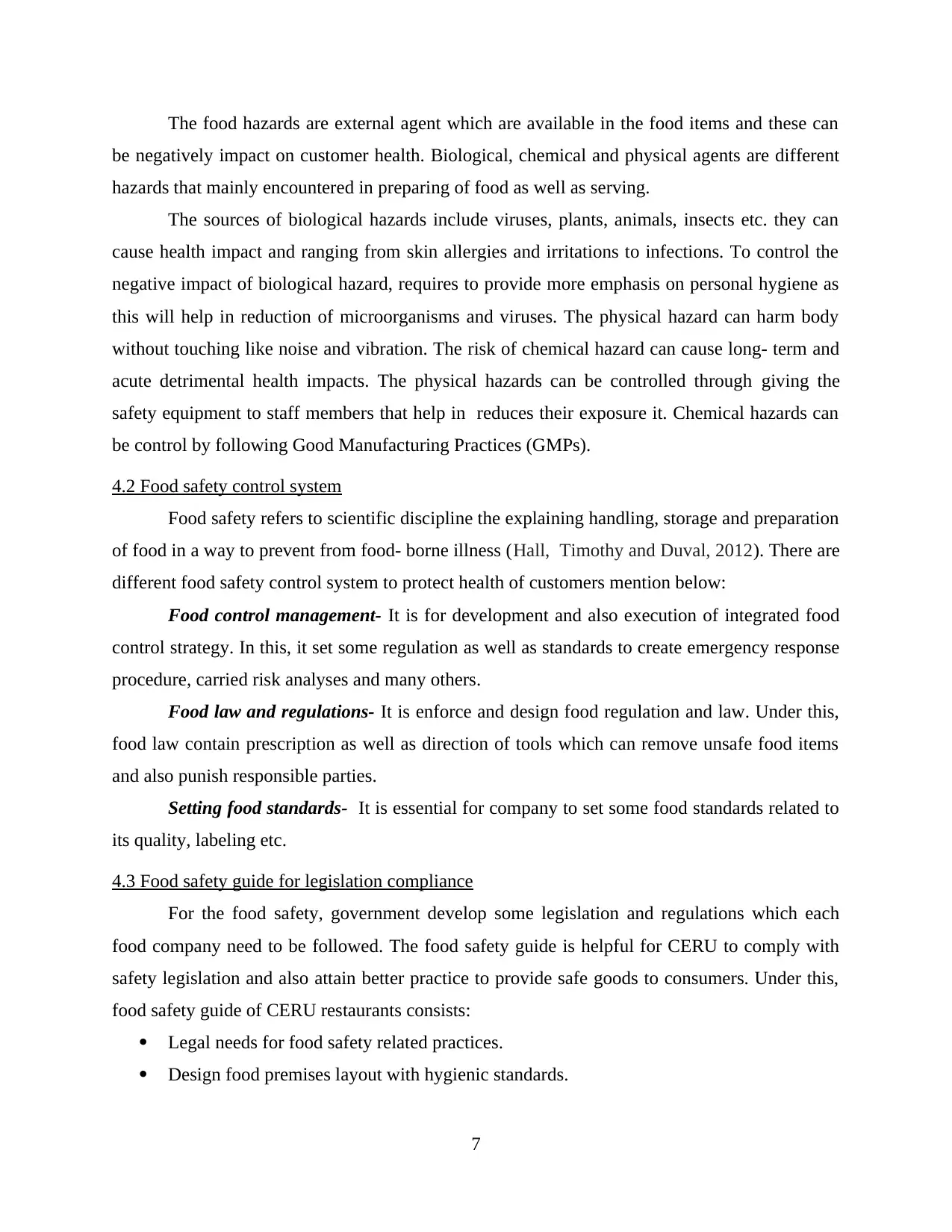
The food hazards are external agent which are available in the food items and these can
be negatively impact on customer health. Biological, chemical and physical agents are different
hazards that mainly encountered in preparing of food as well as serving.
The sources of biological hazards include viruses, plants, animals, insects etc. they can
cause health impact and ranging from skin allergies and irritations to infections. To control the
negative impact of biological hazard, requires to provide more emphasis on personal hygiene as
this will help in reduction of microorganisms and viruses. The physical hazard can harm body
without touching like noise and vibration. The risk of chemical hazard can cause long- term and
acute detrimental health impacts. The physical hazards can be controlled through giving the
safety equipment to staff members that help in reduces their exposure it. Chemical hazards can
be control by following Good Manufacturing Practices (GMPs).
4.2 Food safety control system
Food safety refers to scientific discipline the explaining handling, storage and preparation
of food in a way to prevent from food- borne illness (Hall, Timothy and Duval, 2012). There are
different food safety control system to protect health of customers mention below:
Food control management- It is for development and also execution of integrated food
control strategy. In this, it set some regulation as well as standards to create emergency response
procedure, carried risk analyses and many others.
Food law and regulations- It is enforce and design food regulation and law. Under this,
food law contain prescription as well as direction of tools which can remove unsafe food items
and also punish responsible parties.
Setting food standards- It is essential for company to set some food standards related to
its quality, labeling etc.
4.3 Food safety guide for legislation compliance
For the food safety, government develop some legislation and regulations which each
food company need to be followed. The food safety guide is helpful for CERU to comply with
safety legislation and also attain better practice to provide safe goods to consumers. Under this,
food safety guide of CERU restaurants consists:
Legal needs for food safety related practices.
Design food premises layout with hygienic standards.
7
be negatively impact on customer health. Biological, chemical and physical agents are different
hazards that mainly encountered in preparing of food as well as serving.
The sources of biological hazards include viruses, plants, animals, insects etc. they can
cause health impact and ranging from skin allergies and irritations to infections. To control the
negative impact of biological hazard, requires to provide more emphasis on personal hygiene as
this will help in reduction of microorganisms and viruses. The physical hazard can harm body
without touching like noise and vibration. The risk of chemical hazard can cause long- term and
acute detrimental health impacts. The physical hazards can be controlled through giving the
safety equipment to staff members that help in reduces their exposure it. Chemical hazards can
be control by following Good Manufacturing Practices (GMPs).
4.2 Food safety control system
Food safety refers to scientific discipline the explaining handling, storage and preparation
of food in a way to prevent from food- borne illness (Hall, Timothy and Duval, 2012). There are
different food safety control system to protect health of customers mention below:
Food control management- It is for development and also execution of integrated food
control strategy. In this, it set some regulation as well as standards to create emergency response
procedure, carried risk analyses and many others.
Food law and regulations- It is enforce and design food regulation and law. Under this,
food law contain prescription as well as direction of tools which can remove unsafe food items
and also punish responsible parties.
Setting food standards- It is essential for company to set some food standards related to
its quality, labeling etc.
4.3 Food safety guide for legislation compliance
For the food safety, government develop some legislation and regulations which each
food company need to be followed. The food safety guide is helpful for CERU to comply with
safety legislation and also attain better practice to provide safe goods to consumers. Under this,
food safety guide of CERU restaurants consists:
Legal needs for food safety related practices.
Design food premises layout with hygienic standards.
7
⊘ This is a preview!⊘
Do you want full access?
Subscribe today to unlock all pages.

Trusted by 1+ million students worldwide
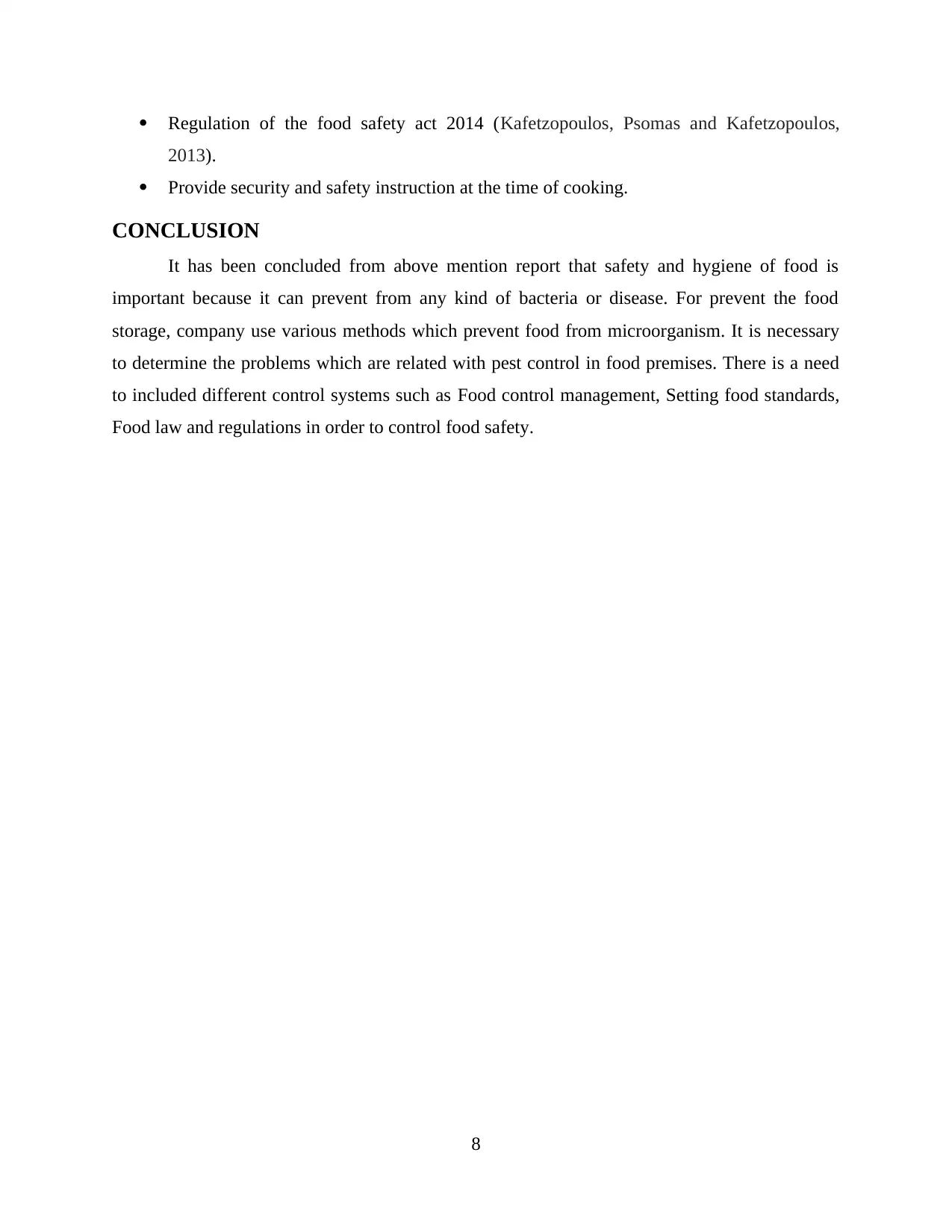
Regulation of the food safety act 2014 (Kafetzopoulos, Psomas and Kafetzopoulos,
2013).
Provide security and safety instruction at the time of cooking.
CONCLUSION
It has been concluded from above mention report that safety and hygiene of food is
important because it can prevent from any kind of bacteria or disease. For prevent the food
storage, company use various methods which prevent food from microorganism. It is necessary
to determine the problems which are related with pest control in food premises. There is a need
to included different control systems such as Food control management, Setting food standards,
Food law and regulations in order to control food safety.
8
2013).
Provide security and safety instruction at the time of cooking.
CONCLUSION
It has been concluded from above mention report that safety and hygiene of food is
important because it can prevent from any kind of bacteria or disease. For prevent the food
storage, company use various methods which prevent food from microorganism. It is necessary
to determine the problems which are related with pest control in food premises. There is a need
to included different control systems such as Food control management, Setting food standards,
Food law and regulations in order to control food safety.
8
Paraphrase This Document
Need a fresh take? Get an instant paraphrase of this document with our AI Paraphraser
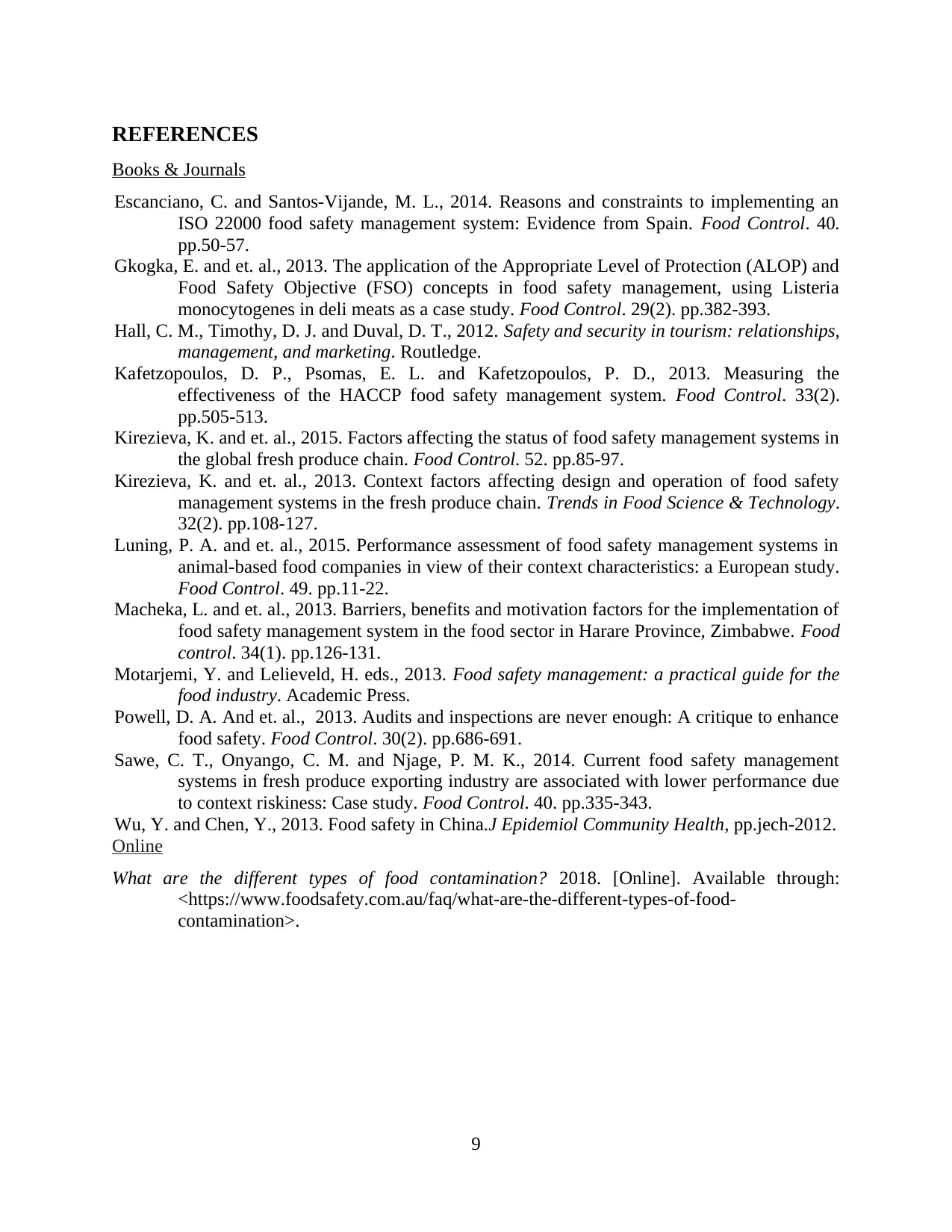
REFERENCES
Books & Journals
Escanciano, C. and Santos-Vijande, M. L., 2014. Reasons and constraints to implementing an
ISO 22000 food safety management system: Evidence from Spain. Food Control. 40.
pp.50-57.
Gkogka, E. and et. al., 2013. The application of the Appropriate Level of Protection (ALOP) and
Food Safety Objective (FSO) concepts in food safety management, using Listeria
monocytogenes in deli meats as a case study. Food Control. 29(2). pp.382-393.
Hall, C. M., Timothy, D. J. and Duval, D. T., 2012. Safety and security in tourism: relationships,
management, and marketing. Routledge.
Kafetzopoulos, D. P., Psomas, E. L. and Kafetzopoulos, P. D., 2013. Measuring the
effectiveness of the HACCP food safety management system. Food Control. 33(2).
pp.505-513.
Kirezieva, K. and et. al., 2015. Factors affecting the status of food safety management systems in
the global fresh produce chain. Food Control. 52. pp.85-97.
Kirezieva, K. and et. al., 2013. Context factors affecting design and operation of food safety
management systems in the fresh produce chain. Trends in Food Science & Technology.
32(2). pp.108-127.
Luning, P. A. and et. al., 2015. Performance assessment of food safety management systems in
animal-based food companies in view of their context characteristics: a European study.
Food Control. 49. pp.11-22.
Macheka, L. and et. al., 2013. Barriers, benefits and motivation factors for the implementation of
food safety management system in the food sector in Harare Province, Zimbabwe. Food
control. 34(1). pp.126-131.
Motarjemi, Y. and Lelieveld, H. eds., 2013. Food safety management: a practical guide for the
food industry. Academic Press.
Powell, D. A. And et. al., 2013. Audits and inspections are never enough: A critique to enhance
food safety. Food Control. 30(2). pp.686-691.
Sawe, C. T., Onyango, C. M. and Njage, P. M. K., 2014. Current food safety management
systems in fresh produce exporting industry are associated with lower performance due
to context riskiness: Case study. Food Control. 40. pp.335-343.
Wu, Y. and Chen, Y., 2013. Food safety in China.J Epidemiol Community Health, pp.jech-2012.
Online
What are the different types of food contamination? 2018. [Online]. Available through:
<https://www.foodsafety.com.au/faq/what-are-the-different-types-of-food-
contamination>.
9
Books & Journals
Escanciano, C. and Santos-Vijande, M. L., 2014. Reasons and constraints to implementing an
ISO 22000 food safety management system: Evidence from Spain. Food Control. 40.
pp.50-57.
Gkogka, E. and et. al., 2013. The application of the Appropriate Level of Protection (ALOP) and
Food Safety Objective (FSO) concepts in food safety management, using Listeria
monocytogenes in deli meats as a case study. Food Control. 29(2). pp.382-393.
Hall, C. M., Timothy, D. J. and Duval, D. T., 2012. Safety and security in tourism: relationships,
management, and marketing. Routledge.
Kafetzopoulos, D. P., Psomas, E. L. and Kafetzopoulos, P. D., 2013. Measuring the
effectiveness of the HACCP food safety management system. Food Control. 33(2).
pp.505-513.
Kirezieva, K. and et. al., 2015. Factors affecting the status of food safety management systems in
the global fresh produce chain. Food Control. 52. pp.85-97.
Kirezieva, K. and et. al., 2013. Context factors affecting design and operation of food safety
management systems in the fresh produce chain. Trends in Food Science & Technology.
32(2). pp.108-127.
Luning, P. A. and et. al., 2015. Performance assessment of food safety management systems in
animal-based food companies in view of their context characteristics: a European study.
Food Control. 49. pp.11-22.
Macheka, L. and et. al., 2013. Barriers, benefits and motivation factors for the implementation of
food safety management system in the food sector in Harare Province, Zimbabwe. Food
control. 34(1). pp.126-131.
Motarjemi, Y. and Lelieveld, H. eds., 2013. Food safety management: a practical guide for the
food industry. Academic Press.
Powell, D. A. And et. al., 2013. Audits and inspections are never enough: A critique to enhance
food safety. Food Control. 30(2). pp.686-691.
Sawe, C. T., Onyango, C. M. and Njage, P. M. K., 2014. Current food safety management
systems in fresh produce exporting industry are associated with lower performance due
to context riskiness: Case study. Food Control. 40. pp.335-343.
Wu, Y. and Chen, Y., 2013. Food safety in China.J Epidemiol Community Health, pp.jech-2012.
Online
What are the different types of food contamination? 2018. [Online]. Available through:
<https://www.foodsafety.com.au/faq/what-are-the-different-types-of-food-
contamination>.
9
1 out of 11
Related Documents
Your All-in-One AI-Powered Toolkit for Academic Success.
+13062052269
info@desklib.com
Available 24*7 on WhatsApp / Email
![[object Object]](/_next/static/media/star-bottom.7253800d.svg)
Unlock your academic potential
Copyright © 2020–2025 A2Z Services. All Rights Reserved. Developed and managed by ZUCOL.





